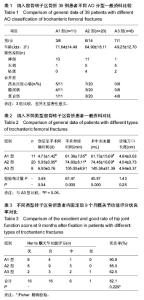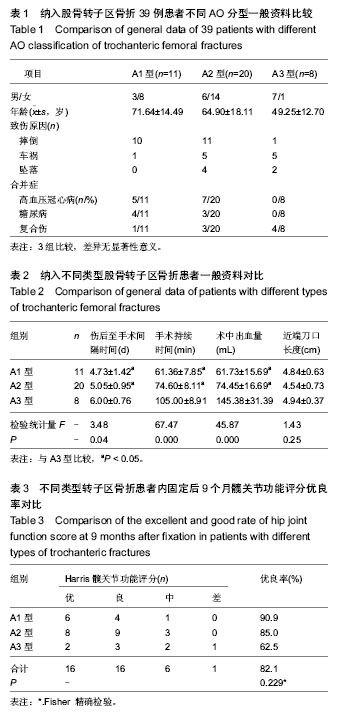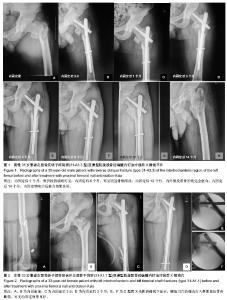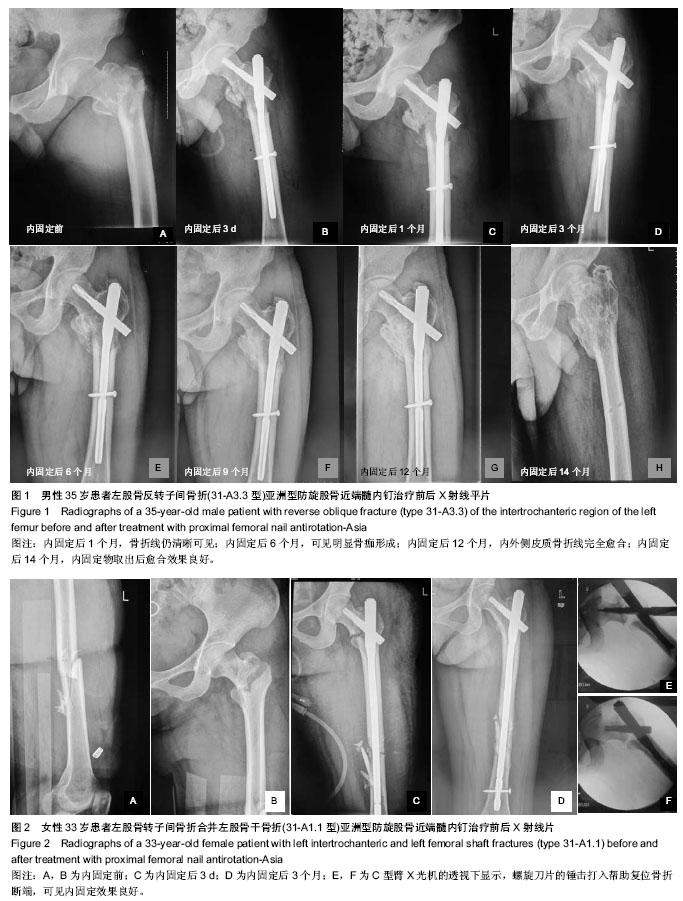| [1] Hutchings L, Fox R, Chesser T. Proximal femoral fractures in the elderly: how are we measuring outcome? Injury. 2011; 42(11):1205-1213.
[2] Kokoroghiannis C, Aktselis I, Deligeorgis A, et al. Evolving concepts of stability and intramedullary fixation of intertrochanteric fractures--a review. Injury. 2012;43(6):686-693.
[3] Gavaskar AS, Subramanian M, Tummala NC. Results of proximal femur nail antirotation for low velocity trochanteric fractures in elderly. Indian J Orthop. 2012;46(5):556-560.
[4] Tyagi V, Yang JH, Oh KJ. A computed tomography-based analysis of proximal femoral geometry for lateral impingement with two types of proximal femoral nail anterotation in subtrochanteric fractures. Injury. 2010;41(8):857-861.
[5] 刘钊,沈惠良,刘利民,等. 亚洲钉治疗老年股骨粗隆间骨折的疗效分析[J].45中国骨与关节损伤杂志,2011,26(4):289-291.
[6] 叶成,董建文.长柄人工双动股骨头置换、DHS及PFN治疗高龄患者股骨粗隆间骨折的对比研究[J].临床医学,2013,9(6):14-17.
[7] 谢逸波,李泽龙,徐慰凯.防旋型股骨近端髓内钉与动力髋螺钉治疗老年股骨粗隆间骨折的疗效比较[J].广东医学,2013,34(13): 2019-2021.
[8] Zhang L, Mao Z, Tang P. Comments on Kokoroghiannis et al.: Evolving concepts of stability and intramedullary fixation of intertrochanteric fractures--a review. Injury. 2013;44(6): 877-878.
[9] Wang WY, Yang TF, Liu L, et al. A comparative study of ipsilateral intertrochanteric and femoral shaft fractures treated with long proximal femoral nail antirotation or plate combinations. Orthop Surg. 2012;4(1):41-46.
[10] 王奔,葛振新,杨国跃,等.髓内与髓外固定修复股骨转子间骨折的Meta分析[J].中国组织工程研究,2013,17(4):736-743.
[11] Traumatic arthritis of the hip after dislocation and acetabular fractures: treatment by mold arthroplasty. An end-result study using a new method of result evaluation. J Bone Joint Surg Am. 1969;51(4):737-755.
[12] 沈光银. 防旋股骨近端髓内钉与动力髋螺钉治疗 老年股骨粗隆间骨折疗效比较[J].中国修复重建外科杂志,2012,26(6): 671-674.
[13] Tang P, Hu F, Shen J, et al. Proximal femoral nail antirotation versus hemiarthroplasty: a study for the treatment of intertrochanteric fractures. Injury. 2012;43(6):876-881.
[14] Mereddy P, Kamath S, Ramakrishnan M, et al.The AO/ASIF proximal femoral nail antirotation (PFNA): a new design for the treatment of unstable proximal femoral fractures. Injury. 2009;40(4):428-432.
[15] 梁春雨,张柳,平少华,等.应用股骨近端髓内钉与动力髋(髁)螺钉治疗老年股骨转子间骨折的对比分析[J].中国矫形外科杂志, 2011,19(24):2038-2040.
[16] 侯克东,马东印,周自广.PFNA与Inter Tan治疗老年股骨粗隆间骨折的临床研究[J].中国矫形外科杂志,2012,20(18):1705- 1706.
[17] Macheras GA, Koutsostathis SD, GalanakosS,et al. Does PFNA Ⅱavoid lateral cortex impingement for unstable peritrochanteric fractures?. Clin Orthop Relat Res. 2012;470 (11):3067-3076.
[18] 王文岳,杨天府,方跃,等. 防旋股骨近端髓内钉治疗股骨逆转子间骨折[J]. 中国修复重建外科杂志,2009,23(11):1306-1310.
[19] 陆建华,施晓健,刁振鸿,等.PFNA联合鲑鱼降钙素微创治疗高龄股骨粗隆间骨折[J].中国矫形外科杂志,2012,20(6):563-565.
[20] 马佶,谢振钧.PFNA微创治疗老年股骨粗隆间骨折疗效[J].中国老年学杂志,2011,12(31):4930-4931.
[21] Takigami I, Matsumoto K, Ohara A, et al.Treatment of trochanteric fractures with the PFNA (proximal femoral nail antirotation) nail system-report of early results. Bull NYU Hosp Jt Dis. 2008;66(4):276-279.
[22] 陶正刚,韦盛旺,赵友明,等.三种不同内固定方式治疗股骨转子间不稳定型骨折的疗效比较[J].中华创伤骨科杂志,2012, 14(2): 108-112.
[23] 张道俭,柴卫兵,米川,等. PFNA与DHS+TSP治疗股骨粗隆间不稳定型骨折临床疗效对比分析[J].中国矫形外科杂志,2012, 20(16):1459-1462.
[24] 李慧武,孙月华,史定伟,等.股骨近端防旋髓内钉治疗老年股骨转子间骨折112例[J].中华创伤杂志,2011,27(11):990-994.
[25] Brunner A, Jöckel JA, Babst R. The PFNA proximal femur nail in treatment of unstable proximal femur fractures 3 cases of postoperative perforation of the helical blade into the hip joint. J Orthop Trauma. 2008;22(10):731-736.
[26] 秦晖,安智全.InterTan治疗股骨粗隆间骨折的疗效评估[J].中国修复重建外科杂志,2010,24(12):1424-1427.
[27] Pu JS,Liu L,Wang GL,et al. Results of the proximal femoral nail antirotation(PFNA) in elderly Chinese patients. Int Orthop. 2009;33(5):1441-1444.
[28] 汪金平,杨天府,宁建君,等.两种髓内钉固定股骨干骨折合并同侧髋部骨折的疗效比较[J].中国修复重建外科杂志,2012,26(8): 905-909.
[29] 谢加兵,徐祝军,丁国正,等.移动式C 型臂X 射线机图像拼接在骨科手术中的应用[J].中国组织工程研究,2013,17(17): 3117-3123. |



